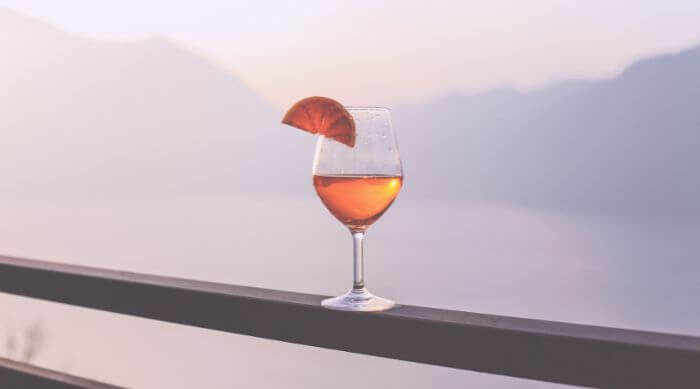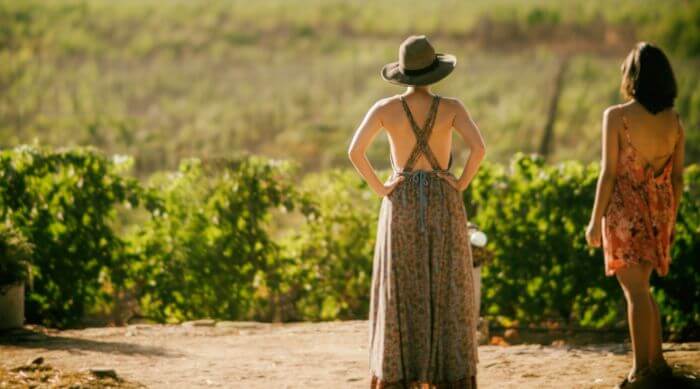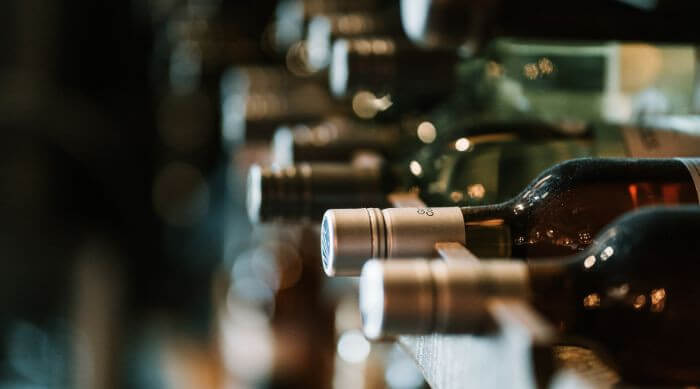Orange wine is one of the most unique wine styles to understand. It’s color is definitely orange, but it’s not made of oranges. It’s thousands of years old, but many casual wine drinkers have never had a sip.
What is special about orange wine? The unique flavor profile and color of orange wine is what makes it so special. It’s made of white wine grapes but has a bolder texture closer to red wine. That distinction is due to how orange wine is made.
Non-Alcoholic Sparkling Brut
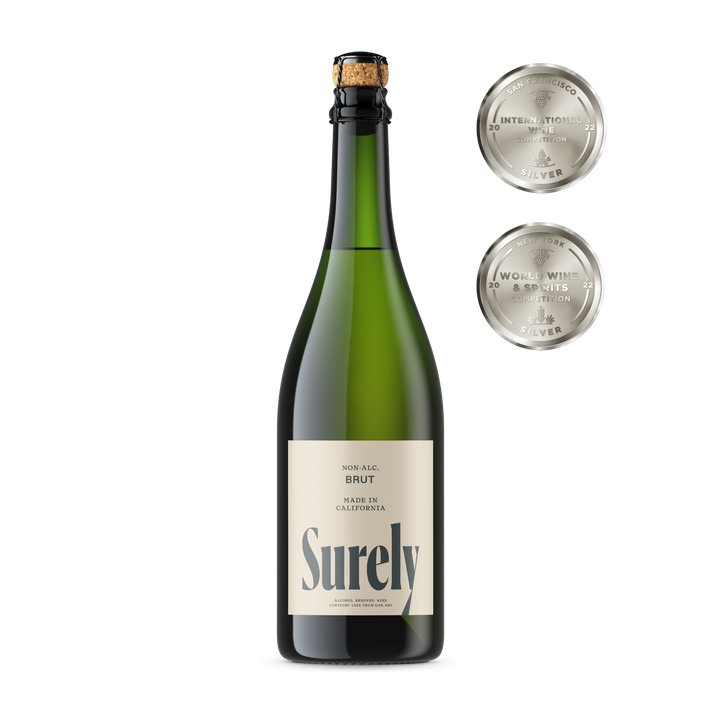
$24.99
Award-winning alcohol-removed bubbly white. Hints of apple, pear, honey and citrus notes. Better than champagne.TASTING NOTES: The vibrant combination of apple, pear, honey and citrus notes intertwined with a crisp backbone. The acid and sweet notes of the fruit pair… Read More
Table of Contents
How Is Orange Wine Made?
Orange wine isn’t made from oranges. In fact, you won’t find any citrus fruits involved in the winemaking process for this type of wine.
How do you make an orange wine? You make an orange wine by leaving the grape skins on white grapes in the fermentation process. That’s why orange wine also goes by the name “skin-contact white wine.”
The process from there depends on the winemaker. Orange wines are more likely to be considered natural wines. This means no additives or preservatives are in the final product. Pét-nats, or pétillant naturel wines, resemble orange wine, but in sparkling form.
Organic or biodynamic winemakers take it a step further with grapes grown without chemical interventions, but that’s not something that’s true of all orange wines.
The resulting color of an orange wine depends on the amount of time the grape juices soak with the mashed grape skins, seeds, and stems as part of the maceration process. Orange wines can look like honey-colored, copper, or amber wines.
Fun fact: The color of any wine comes from the hue of the grape skins. This can depend on the grape variety. With white wine, winemakers remove the skins immediately after they’re crushed to avoid unwanted pigment. With rosé, red grape skins touch the wine for a brief period of time.
How is orange wine made vs. red wine? Orange wine is made of white wine grapes. Red wine is made of red grapes. Red wine hues can vary a bit, too. The richness and thickness of a red or black grape skin and a longer skin maceration period can all result in a deeper red wine.
As with red and white wines, orange wine also contains antioxidants that some say make wine a healthier option than other types of alcohol. Orange wines have more resveratrol, an antioxidant found in grape skins, compared to white wines because they’re a skin-contact wine.
Here’s our disclaimer: If you’re not already a wine drinker, you can get more health benefits by eating a handful of grapes than drinking a glass of wine.
Does It Taste Like Oranges?
Orange wine doesn’t taste like oranges, but you may get notes of bitter orange rind on that first sip. It all depends on which white wine grape is used.
An orange wine made of Pinot Grigio grapes may come with fruity notes of stone fruit and apricot. Gewürztraminer and muscat grapes are more floral. Classic Georgian orange wines that use native Mtsvane (yep, that’s really how it’s spelled) or Kisi grapes are more herbaceous and nutty.
Is orange wine sweet or dry? Most orange wine is dry, not sweet. Some brands are semi-sweet, but if an orange wine tastes very sweet, it likely has added sugars.
Contact with the grape skins, seeds, and stems adds more phenolic activity and tannins to the wine compared to white varietals, which can make them more bitter and astringent. That tannic aspect of orange wines is why many are closer in flavor and mouthfeel to light red wines.
Orange wines made in steel barrels are more likely to retain the crispness and acidity of a pinot gris or sauvignon blanc.
An orange wine with a higher alcohol by volume (ABV) will taste bolder, too. You’ll find that information on the wine label.
How much alcohol is in orange wine? The amount of alcohol in orange wine varies by bottle, but expect an average ABV of 11-13%.
Food Pairings With Orange Wine
If you’re looking to trade in your go-to chardonnay at your next dinner party for something more interesting, know that a high-quality orange wine can pair with anything. Hints of white wine grapes mean it’s good with seafood, but a more tannic profile means it pairs well with red meat.
What are the benefits of drinking orange wine? The benefits of drinking an orange style of wine are its versatility with food pairings and its unique flavor.
To go a little deeper with your food pairings, choose orange wines based on maceration length.
An orange wine that was only given a week of grape skin contact will be much less tannic and lighter than a wine sitting with grape skins for months. Those are typically the wines with the funkiest tasting notes and aromas.
Those funkier styles match well with beef stews and spicy meals. Orange wines that look pink are likely a blend of grenache and riesling. Those make a great dessert wine or cheese plate pairing. Pair lighter orange wines with fish and pasta.
Just make sure to serve your orange wine slightly chilled.
How many calories are in an ounce of orange wine? There are about 20 calories in an ounce of orange wine. That’s a little less than bolder red wines and comparable to white wines, so it’s unlikely to cause you belly bloat if enjoyed in moderation. A standard pour of any wine is 5 oz.
History of Orange Wine
Orange winemaking goes back thousands of years. The earliest records point to the Caucasus and the modern-day country of Georgia as the first producers of orange wine.
Ancient winemakers fermented the wine in clay vessels called qvevris with the stems and grape skins intact. Countries like Slovenia and Italy imported the vessels to make their own version in the centuries that followed.
It’s a method still used by many orange winemakers today, particularly Georgian winemakers who have been producing orange wine for centuries.
What countries produce orange wine? Countries all over the world produce orange wine. It’s particularly popular in Slovenia, Germany, France, Spain, Austria, Croatia, New Zealand, and the Italian region of Friuli-Venezia Giulia.
Portugal, Australia, South Africa, and wine regions around the United States like Napa Valley in California and Oregon’s Willamette Valley have also added orange wines to their wine clubs.
Orange Wine on the Market
The easiest way to get to know orange wine is to chat with sommeliers at your local wine bars or wineries. If that’s not possible, there are a number of niche and more popular brands and wine importers that have embraced orange wine styles as part of their wine production.
Here are a few big names in the orange wine game:
- Orgo: Georgian winemaker Gogi Dakishvilli uses Old World qvevris to create light amber wines like the Dialo Rkatsitlegi-Mtsvane.
- Gravner: Josko Gravner is considered the father of orange wine in Friuli Venezia Giulia. Expect to wait at least seven years after each harvest for bottles of Ribolla Gialla.
- Radikon: This is another big-name winemaker on the Italian-Slovenian border. Their Sivi, a pinot grigio, is the most well-known varietal among their imports.
- Mas Théo: Winemaker Laurent Clapier offers an affordable approach to orange wine. Try “Ginger,” a white blend of Marsanne, Rousanne, and Grenache blanc light on tannins.
- Donkey & Goat: This Berkeley wine brand has become a leader in the California natural wine movement. Try their Stone Crusher for their take on skin-contact Roussanne.
Non-Alcoholic Red Blend
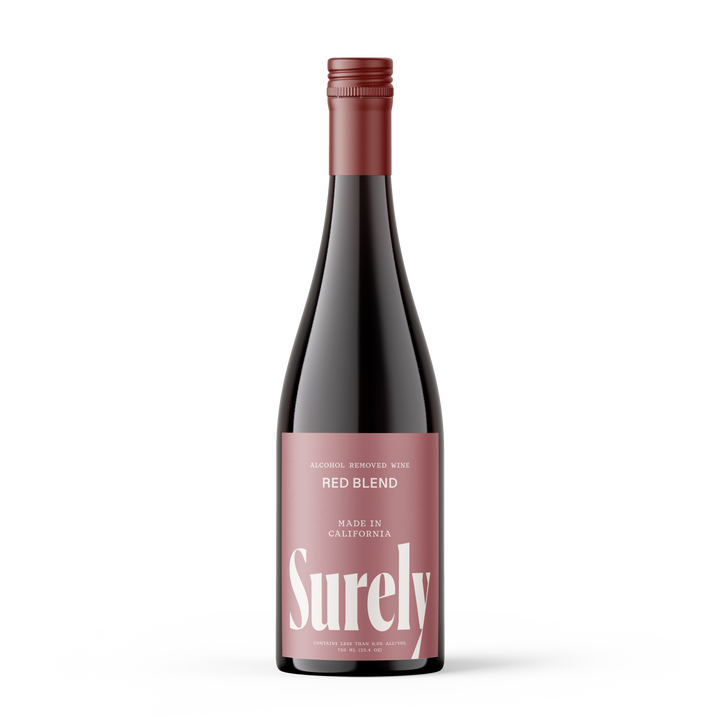
$24.99
Smooth tannins with red fruit of raspberry and plum, rounded out with light finish of vanilla and oak. … Read More
Would You Try It?
Orange wine can be a fun addition to your alcoholic drink menu, but we love serving up options that everyone can enjoy. Experiment even further with non-alcoholic versions of your favorite wines from Surely.
If you like a dry red, our non-alcoholic red blend is a complex blend of smoke and spice. For a pop of pink, try our non-alcoholic sparkling rosé, a light, fruity wine that’s big on bubbles without the hangover.

